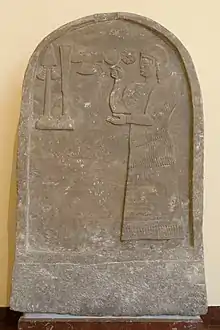Bēl-Ḫarrān-bēlu-uṣur
Bēl-harrān-bēli-uṣur war ein hoher Beamter Adad-niraris III. und Tukulti-apil-Ešarras III. im 8. Jahrhundert v. Chr. Er war unter anderem „Herold des Palastes“ (nāgir ēkalli), „limmu-Beamter“ und möglicherweise Gouverneur von Guzana. Diese Identifikation ist jedoch sehr unsicher.[1] In einer Inschrift auf einer nördlich von Hatra gefundenen Stele wird sein Name noch vor dem des Königs genannt, was auf außerordentliche Macht hindeutet. In derselben Inschrift berichtet er auch von der Gründung einer Stadt in der Wüste westlich Ninives namens Dur-Bēl-harrān-bēli-uṣur. Dieser Stadt habe er die Befreiung von Steuerlasten zugesichert, ein Privileg, das sonst nur dem König zustand.

Bel-Harran-beli-usur, Archäologisches Museum Istanbul
Literatur
- Grayson, in Cambridge Ancient History III/1, S. 279.
- A. K. Grayson, Assyrian Officials and Power in the 9th and 8th centuries, SAA VII, 1993, S. 19–52.
- A. Moortgat, Geschichte Vorderasiens bis zum Hellenismus, München, 1950 S. 408.
Anmerkungen
- Vgl. Karen Radner: Bēl-Ḫarrān-bēlu-uṣur 3. In: The Prosopography of the Neo-Assyrian Empire 1,II. Helsinki 1999, S. 301.
| Vorgänger | Amt | Nachfolger |
|---|---|---|
| Duri-Aššur | Limmu-Beamter 727/726 v. Chr. | Marduk-bêla-usur |
This article is issued from Wikipedia. The text is licensed under Creative Commons - Attribution - Sharealike. The authors of the article are listed here. Additional terms may apply for the media files, click on images to show image meta data.